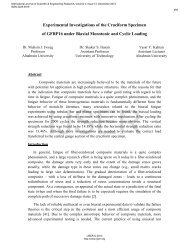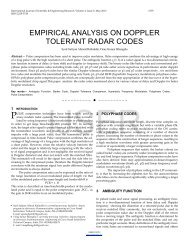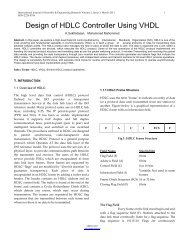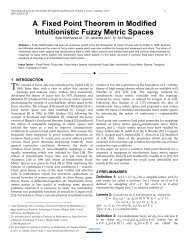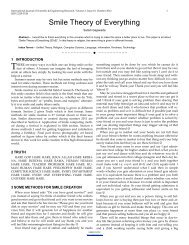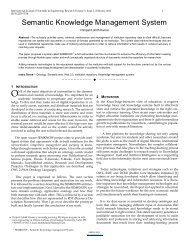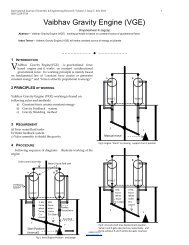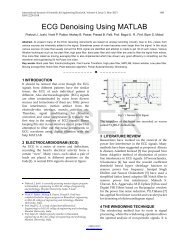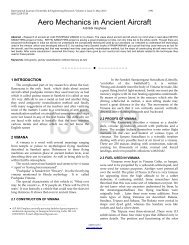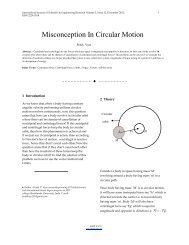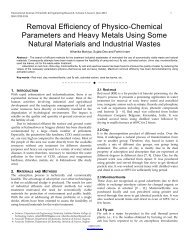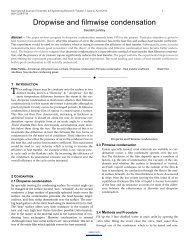Face Detection and Tracking System - International Journal of ...
Face Detection and Tracking System - International Journal of ...
Face Detection and Tracking System - International Journal of ...
You also want an ePaper? Increase the reach of your titles
YUMPU automatically turns print PDFs into web optimized ePapers that Google loves.
<strong>International</strong> <strong>Journal</strong> <strong>of</strong> Scientific & Engineering Research, Volume 3, Issue 10, October-2012 1<br />
ISSN 2229-5518<br />
<strong>Face</strong> <strong>Detection</strong> <strong>and</strong> <strong>Tracking</strong> <strong>System</strong><br />
Susmit Sarkar, Arindam Bose<br />
Abstract— Security Measures are one <strong>of</strong> the things in which technology had entered long time back. Security without Technology cannot<br />
be thought <strong>of</strong> in modern times. Be it in any Bank, Corporate buildings, Educational Institute, anywhere the utilization <strong>of</strong> vision based systems<br />
are used in order to keep a check over the activities going at that place. Robomaniac Intelligent <strong>Tracking</strong> <strong>System</strong> is an intelligent system<br />
which can be used for security purposes. This project combines the joint venture to capture the frames from a camera, detect the faces,<br />
saves the detected faces <strong>and</strong> tracks the faces.<br />
Index Terms— Artificial intelligence, Database management, <strong>Face</strong> detection, Image processiong, Microcontroller, Security system,<br />
<strong>Tracking</strong> system, USART.<br />
—————————— ——————————<br />
1 INTRODUCTION<br />
R<br />
OBOMANIAC Intelligent <strong>Tracking</strong> <strong>System</strong> is an intelligent<br />
system which can be used for security purposes. This<br />
project combines the joint venture to capture the frames<br />
from a camera, detect the faces, saves the detected faces <strong>and</strong><br />
tracks the faces.<br />
This project has six distinct modules:<br />
1. <strong>Face</strong> detection from the frame <strong>and</strong> creation <strong>of</strong> image<br />
<strong>and</strong> video database.<br />
2. Movement <strong>of</strong> camera as per movement <strong>of</strong> person.<br />
3. Counter for how many persons are inside the room.<br />
4. Natural Language Processing<br />
5. <strong>Face</strong> Recognition <strong>System</strong> <strong>and</strong><br />
6. User interface<br />
In this project we have used a Digital camera to acquire the<br />
image. Then we detected the face from the image <strong>and</strong> stored<br />
the face in a database for future use. The system tracks the face<br />
by the camera <strong>and</strong> it stores all the frames in a high FPS MPEG<br />
movie.<br />
2 PROJECT DESCRIPRION<br />
2.1 Data Flow Diagram<br />
Fig. 1 shows the Data Flow Diagram <strong>of</strong> the whole objective.<br />
Live stream is input as frames <strong>and</strong> MPEG video is recorded<br />
from the captured frame in high frame rate. Those MPEG videos<br />
are stored in the video database with frame rate <strong>of</strong> 25 FPS.<br />
Now from the previously captured frame, faces are detected<br />
using HaarCascade algorithm. If an impression <strong>of</strong> face is detected<br />
from any <strong>of</strong> the image the face will be cropped from the<br />
total frame. The image <strong>and</strong> the centre point <strong>of</strong> the face is then<br />
stored in the facial image database. Now a plate attached to<br />
the motor is rotated to change the camera direction <strong>and</strong> it always<br />
places the detected face in the centre <strong>of</strong> the frame to<br />
track the person.<br />
Fig. 1. Data Flow Diagram<br />
IJSER © 2012<br />
http://www.ijser.org
<strong>International</strong> <strong>Journal</strong> <strong>of</strong> Scientific & Engineering Research Volume 3, Issue 10, October-2012 2<br />
ISSN 2229-5518<br />
2.2 The <strong>Face</strong> <strong>Detection</strong><br />
The basic idea behind the <strong>Face</strong> detection is facial color detection.<br />
We all know that human skin consists <strong>of</strong> a wide range<br />
<strong>of</strong> colors. If by any means we could detect those ranges <strong>of</strong> colors,<br />
we can detect a face. This is the basic idea behind face detection.<br />
But as the range is too high we cannot put all the data<br />
just by coding. So we have to take certain idea from the field<br />
<strong>of</strong> Artificial Intelligence. We developed a Simple algorithm <strong>of</strong><br />
learning. The idea was that we will choose some r<strong>and</strong>om faces<br />
<strong>and</strong> the computer will take their picture, detect the components<br />
<strong>of</strong> their skin color separately as RGB <strong>and</strong> stores those<br />
data in a table known as a Look up table. This look up table is<br />
maintained in a XML file <strong>and</strong> is incorporated into the code by<br />
use <strong>of</strong> a classifier.<br />
After the face is detected by the color threshold, we draw a<br />
rectangle box around the detected face. (In our system, it is a<br />
25,000 line long XML file (Look-up table). So; we ensured the<br />
accuracy as 92 %)This rectangle now becomes our Region <strong>of</strong><br />
Interest (ROI). We store this ROI in a Database, so that later<br />
we can access the database to see the people who came to the<br />
room. At the same time the frames where we get the ROI is<br />
joined to form a High FPS Mpeg Video. As we will send the<br />
video over internet, so we recorded the video in high frame<br />
rate to decrease the video size. But in case <strong>of</strong> face images we<br />
used lossless format .bmp. So, the image size will be increased,<br />
but a lossless image format is always better for a future analysis.<br />
Though the space complexity will increase, but the time<br />
complexity will decrease. And in a security system, system<br />
speed is a notable issue. Detected faces <strong>and</strong> videos are shown<br />
in Fig. 2 <strong>and</strong> Fig. 3 respectively.<br />
Fig. 2. <strong>Tracking</strong> videos<br />
Then from the ROI the centre <strong>of</strong> the face is detected by the<br />
meeting point <strong>of</strong> the diagonals <strong>of</strong> the rectangle box. But this<br />
position is with respect to the ROI <strong>and</strong> not with respect to the<br />
original picture. So we have to again convert them with respect<br />
to the whole frame. After that the modified coordinate is<br />
written in a text file in a queue fashion.<br />
Fig. 3. <strong>Face</strong> is detected through the program running behind<br />
Fig. 1. Detected faces stored as images<br />
2.3 Hardware <strong>and</strong> <strong>Tracking</strong><br />
After detection <strong>of</strong> the face we need to trace that by the<br />
camera. So we set the camera on plate fitted with a stepper<br />
motor at the base. For controlling the motor we build a controller<br />
board with ATMega16 microcontroller, Motor Driver<br />
<strong>and</strong> RS232 USART IC. The motor Driver consisted <strong>of</strong> TIP122<br />
Darlington-Pair Transistors. RS232 is used in order to access<br />
the serial port with the controller.<br />
The tracking part is done in MATLAB. After detection as<br />
mentioned earlier the data is written in a text file. Through<br />
MATLAB we read the data <strong>and</strong> check whether the coordinate<br />
is greater than the screen’s centre. If it is greater then write an<br />
‘R’ in the serial port <strong>and</strong> if it is less we write an ‘L’ in the port.<br />
Now via the microcontroller we are continuously checking the<br />
serial port <strong>and</strong> whenever the USART finds any data in the port<br />
it sends that data to the microcontroller. The Microcontroller is<br />
IJSER © 2012<br />
http://www.ijser.org
<strong>International</strong> <strong>Journal</strong> <strong>of</strong> Scientific & Engineering Research Volume 3, Issue 10, October-2012 3<br />
ISSN 2229-5518<br />
programmed with a Case structure which states that if ‘R’ is<br />
detected in the port, then the motor will rotate to the right <strong>and</strong><br />
if it detects ‘L’ then the motor will move towards the left.<br />
2.4 S<strong>of</strong>tware<br />
Any security device consists <strong>of</strong> a database which can be<br />
viewed later. Here also we store the ROI’s in a database, for<br />
accessing the database s<strong>of</strong>tware is being made so that just by<br />
entering the date we can find the peoples who entered the<br />
room on that date. The s<strong>of</strong>tware is prepared in C# in visual<br />
studio. Using this system we can query over the image database<br />
as per the creation date <strong>of</strong> the images. So, this interface<br />
makes the total detection, database management <strong>and</strong> query<br />
system easy <strong>and</strong> user friendly. Also we have included a system<br />
that the databases will be mailed as an attachment to a<br />
particular mail address after a certain interval. If there is any<br />
physical damage to the total hardware system, also then we<br />
can retrieve the images <strong>and</strong> videos via internet.<br />
2.4 Problems<br />
Though we are using OpenCv, we can reduce the processing<br />
lag to a large scale but as we are using a single<br />
webcam to reduce the project cost, certain lag will always be<br />
there. Another important problem is that as the detection is<br />
based on color, the whole system becomes light dependent<br />
<strong>and</strong> for that the size <strong>of</strong> the look up table increases exponentially.<br />
ACKNOWLEDGMENT<br />
We wish to thank Dr. Alok Ghosh, Principal <strong>of</strong> Future Institute<br />
<strong>of</strong> Engineering <strong>and</strong> Management, Pr<strong>of</strong>. Tapas Roy, head<br />
<strong>of</strong> the department <strong>of</strong> computer science engineering <strong>and</strong> Pr<strong>of</strong>.<br />
Debasish Chakraborty, head <strong>of</strong> the department <strong>of</strong> electronics<br />
<strong>and</strong> communication engineering <strong>of</strong> Future Institute <strong>of</strong> Engineering<br />
<strong>and</strong> Management for their sincere help.<br />
REFERENCES<br />
[1] G. Bradsky, A. Kaehler, Learning OpenCV: Computer Vision with the<br />
OpenCV Library.<br />
[2] RC. González, RE. Woods, Digital Image Processing.<br />
[3] Tim Morris, Computer Vision <strong>and</strong> Image Processing. Palgrave Macmillan.<br />
ISBN 0-333-99451-5, 2004.<br />
[4] R. Fisher, K. Dawson-Howe, A. Fitzgibbon, C. Robertson, E. Trucco,<br />
Dictionary <strong>of</strong> Computer Vision <strong>and</strong> Image Processing. John Wiley. ISBN<br />
0-470-01526-8, 2005.<br />
[5] Tinku Acharya <strong>and</strong> Ajoy K. Ray, Image Processing - Principles <strong>and</strong><br />
Applications. Wiley InterScience, 2006.<br />
[6] ATmega16 Datasheet, 2466N–AVR–10/06.<br />
[7] TIP122 Datasheet, Rev. 1.0.0, October 2008.<br />
[8] MAX232 Datasheet, SLLS047I – February 1989 – revised October<br />
2002.<br />
[9] Image Processing, http://en.wikipedia.org/wiki/Image_processing<br />
2012.<br />
[10] OpenCV, http://opencv.willowgarage.com/wiki, 2012.<br />
3 APPLICATION<br />
We can use this system in a robot eye to track any particular<br />
human face when the robot is talking with a human being. In<br />
any examination hall, movie hall or product release house, we<br />
can use this system to record human activities. From which<br />
later the emotion can be detected. As this system is made only<br />
using a single camera so the set-up cost is very low. For higher<br />
technology (face tracking) we were able to short-sized the project<br />
cost as only USD 50.<br />
4 CONCLUSION<br />
Although a conclusion may review the main points <strong>of</strong> the paper,<br />
do not replicate the abstract as the conclusion. A conclusion<br />
might elaborate on the importance <strong>of</strong> the work or suggest<br />
applications <strong>and</strong> extensions. Authors are strongly encouraged<br />
not to call out multiple figures or tables in the conclusion—<br />
these should be referenced in the body <strong>of</strong> the paper.<br />
————————————————<br />
Susmit Sarkar is a B.Tech student <strong>of</strong> computer science engineering in Future<br />
Institute <strong>of</strong> Engineering <strong>and</strong> Management <strong>of</strong> West Bengal University<br />
<strong>of</strong> Technology, India, PH-+918961459411. E-mail: susmit.srkr@gmail.com<br />
Arindam Bose is a B.Tech student <strong>of</strong> electronics <strong>and</strong> communication engineering<br />
in Future Institute <strong>of</strong> Engineering <strong>and</strong> Management <strong>of</strong> West Bengal<br />
University <strong>of</strong> Technology, India, PH-+919051320505. E-mail: adambose1990@gmail.com.<br />
He is the author <strong>of</strong> several article papers published in<br />
<strong>International</strong> <strong>Journal</strong>s.<br />
IJSER © 2012<br />
http://www.ijser.org


